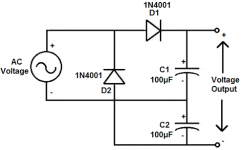With the Delon full wave doubler circuit below... Does increasing the capacitance give better load regulation stability up to a point? I'll be following this up with an RC filter and regulator so ripple reduction isn't my concern. But was wondering at what point increasing the capacitance in the doubler itself ceases to be worthwhile. The total load I want to keep at 50% of what I know the doubler can provide anyway so I'll size the transformer appropriately.
So is increasing the capacitance here to say 1000uF going to be an improvement, a problem, or "makes no difference" stability wise for the final amp sag-wise?

So is increasing the capacitance here to say 1000uF going to be an improvement, a problem, or "makes no difference" stability wise for the final amp sag-wise?

Last edited:
Not regulation, it will give you less ripple and somewhat more instantaneous peak current; average regulation (along many AC cycles) will remain about same.
Make sure that your transformer can handle the larger current pulses due to the larger capacitors.
Conduction angle goes down, peak current goes up with higher capacitace. And of course ripple goes down, average voltage goes up slightly. But RMS current and ripple current don't increase much - RMS is all the transformer cares about. Size the caps for your ripple requirement.
If this is for an audio amplifier, it’s not really the ripple per se that you size the caps for. The cap is sized for the required pole frequency between the load and the cap. Size it as you would an OUTPUT cap if your amp were capacitively coupled. The load is both channels in parallel, the cap is the effective value of both in series. The cap causes the maximum power to roll off at low frequency, for the same reason it does with an output cap - it is in series with the load. Closed loop response is not affected by the cap, but the maximum possible output at X Hz is.
If you go through the math, you’ll see why going above 20,000 uF in a typical amp is useless. If this is for a *tube* amp where you would likely use a doubler, you’ll find the required cap values quite reasonable because the load on each channel is (Ra-a)/4 for push pull, not a number close to 4 or 8.
If you go through the math, you’ll see why going above 20,000 uF in a typical amp is useless. If this is for a *tube* amp where you would likely use a doubler, you’ll find the required cap values quite reasonable because the load on each channel is (Ra-a)/4 for push pull, not a number close to 4 or 8.